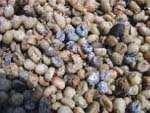
Careful selection of red cherries at harvesting is essential for good quality coffee. To make pulping and grading easier, process only ripe, red cherries; do not use a mixture of red, over or under-ripe cherries (Figure 32). Potential damage to coffee beans is reduced as the pulping machine can be better adjusted to the one type of red cherry.
|
- Unripe cherries downgrade coffee quality - |
In Lao, harvesting for Arabica takes place from October through December and for Robusta, December through February (see the crop cycle - phenology, chart for details). Clean, washed bags should be used to collect the harvested fruits; NEVER use bags that have contained fertiliser or other chemicals. Cherries should be processed the same day as harvesting and should not be mixed with the previous day's harvest. Equipment and sorting areas should be checked daily and kept thoroughly washed clean. Any fermented part of cherry from the previous day will contaminate the newly harvested cherries and result in deteriotation of the entire batch. Carefully wash and sort cherries before starting the processing to remove twigs, leaves or other foreign matter.
Coffee processing transforms fresh coffee cherries into clean, green bean of 12% moisture ready for export or for roasting. This process involves harvesting, pulping, fermenting, washing, drying, hulling, cleaning, grading, sorting, storing and transporting green beans. The process can be broadly divided into two main components - Wet Processing (cherry to dry parchment) and Dry Processing (dry parchment to exportable green bean).
It is important to understand that each of these steps has an influence on the final quality of coffee produced. Processing is a chain of activities aimed at achieving a coffee of high quality. If any link in the chain is broken (such as over-fermentation, mould contamination, taints or odours or physical damage to the bean) then that loss in quality can never be regained.
Three main processing methods are the basis for the range of coffee processing techniques used throughout the world - natural, semi-wash and full-wash (Figure 33 shows the last two processes).
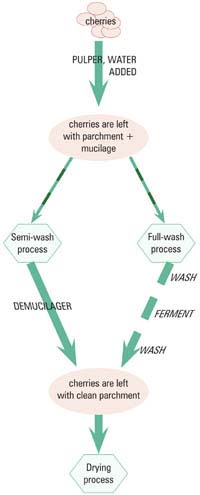
Figure 33. Simplified diagram of semi and full washing processes
Natural process
This is a one-step operation where the coffee bean is dried inside the whole coffee fruit to 12% moisture. The dry cherry is then hulled to produce a dry green bean. This is the low cost, traditional system resulting in a low quality coffee, and is not recommended. In Lao, most Robusta coffee is currently processed this way.
Full-washed process
The skin of the fresh cherry is physically removed using a pulper machine with addition of water (pulping). The sugar coating (mucilage) is allowed to ferment over one to two days and then the parchment is washed thoroughly to remove all traces of fermented mucilage. The parchment is dried until the bean inside reaches 12% moisture. This process can produce high quality coffee, but requires large quantities of water (between 2 to 10 L water per kg of fresh cherry) and requires very good management of the fermentation and washing process to ensure the coffee flavour is not damaged in the process.
Semi-washed process
The skin of the fresh cherry is physically removed by a pulper machine with addition of water, as with full-washed processing. The mucilage is then removed immediately after pulping using a demucilager. Notably this process does not ferment the mucilage as it is mechanically removed by a demucilager. Immediately after demucilaging, the clean parchment is ready for drying until the bean inside reaches 12% moisture.
Recent studies in Lao and Myanmar have shown that pulper/demucilager units are a cost efficient and an effective way to consistently produce high quality coffee without the need for fermentation and washing. These units typically use only 0.5 L of water per kg of fresh cherry and reduce the risk of over-fermentation and quality problems in the final coffee product. While there is an initial capital cost to purchase the pulper and demucialger units, there is no need for fermentation tanks and washing systems. Pulper/demucilager units are recommended for semi-washed wet coffee processing, in Lao.
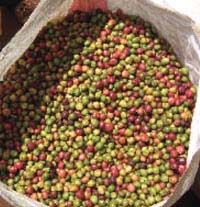
Natural process
Coffee cherries are laid out in the
sun to dry
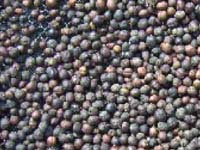
|
Shed and wet processing equipment supplied by FAO project to CREC for trials, demonstrations and use by CREC |
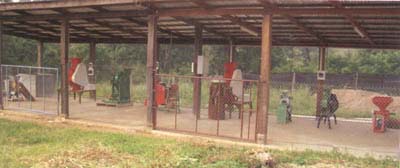
Semi-wash process
Pulper (right background of
photograph) and demucilager units produce clean parchment coffee ready for
drying. VINACAFE unit is shown in photograph. Inexpensive and good for
smallholders; processes 0.5 MT/hr cherry

|
Demucilaging adds body and character to coffee liquor |
|
Full-wash process |
Full-wash process |
|
Pulper unit removes skin |
Cherry is washed, fermented and washed again to remove the mucilage |
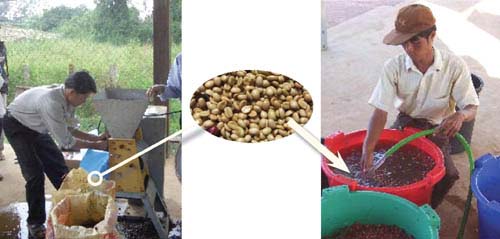
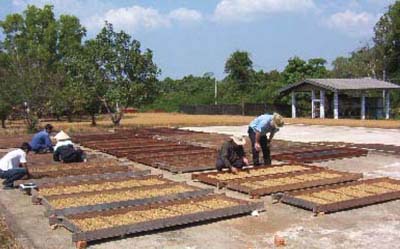
Figure 34. The beans are dried on a clean, flat surface in full sun
The drying process
Drying can be done in full sun on a hard, flat, clean surface such as concrete slabs, tarpaulins, mats, raised tables or trays with a mesh base (Figure 34). Drying should remove moisture from the coffee bean in a slow and continuous process until the bean is at 12% moisture. Drying coffee directly on soil or dirty surfaces can lead to dirty or earthy flavours in the finished coffee. Rewetting of the coffee or storage of partially dried coffee due to rain is a major problem facing sun-dried coffee. Drying coffee too slowly by spreading it too thick on drying areas is also a major problem. Each of these situations can lead to fermented or fruity flavours in the coffee along with mould-growth producing mouldy or musty flavours.
|
The European Coffee Cooperative (ECC) Guidelines on Processing and Handling of Coffee to Minimise OTA, provide more detailed information. |

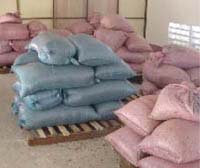
Figure 35. Jute bags for storing parchment coffee (top). Woven poly bags (below) for green beans in a warehouse that ideally should remain at less than 65% relative humidity. Note the low ventilation windows in the wall on the right in the photograph
|
The carcinogenic toxin, Ochratoxin A (OTA) can also be produced in mouldy coffee. Mouldy coffee should be avoided in all circumstances. |
Controlling the drying process to ensure that coffee is not over-dried is important. Over-dried coffee is easily damaged during hulling and may also result in a bland flavour in the final cup. Drying cherry coffee may take 18 to 20 days. Parchment coffee dries in about 9 to 10 days. During the precess, coffee must be covered with polythene or plastic sheets if rain occurs and every night to stop re-wetting that results in mould development. Coffee is fully dry when green bean is a translucent, jade green colour and 12% moisture content. When bitten with the teeth, the bean is dry when it is barely marked, and over-dry (8 to 10% moisture) if it breaks.
Storage of dry parchment
Once parchment has been dried so that the green bean has reached 12% moisture, it can be stored while the grower / processor decides when it will be sold or hulled. Mould can grow on stored coffee if it has not been dried sufficiently before storage or if the stored coffee absorbs moisture from the atmosphere due to humid conditions. This can lead to mouldy or musty flavours. Storage areas must be kept isolated from strong smelling liquid such as petrol or diesel, or agricultural fertilizers and chemicals, as stored coffee can take on these odours which will continue to the final cup.
Parchment coffee or dry cherry is stored on-farm in either jute bags (Figure 35) sometimes covered with polyethylene covers, or in woven polyethylene sacks covered with a polyethylene sheet, or in special polyethylene bags or silos. If not carefully managed, parchment or green bean stored in uncovered jute sacks in a moist climate, will absorb moisture and go mouldy. Poorly ventilated warehouses and relative humidity situations over 65% will create mould problems.
Hulling and sorting dry parchment
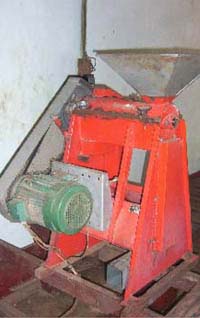
Figure 36. Hulling machine (above) and beans with parchment removed after hulling
Hulling dry parchment is a mechanical process to remove the dry parchment skin and silver skin from the green bean (Figure 36). If the huller is set incorrectly or the coffee is over-dry and brittle, coffee beans can be damaged. If the coffee is too wet the beans can be crushed. There are a range of machines that are able to clean and sort hulled coffee by colour, size, density and aerodynamic shape (Figures 36 to 39). Ultimately the human eye is used as the final process to 'hand-sort' coffee ready for export. However, even with the wide range of machinery available, coffee that has picked up off-flavours but otherwise looks normal, cannot be sorted, and is only identified in the cup when it is too late.
Storage of green bean
Stored, green bean is very susceptible to being contaminated by nearby chemicals or fuels. Storage and shipment of green bean in jute sacks that have been made on machinery lubricated with petroleum oils, can lead to a 'baggy' or 'oily' taste in the coffee. Use clean, jute sacks specially made for coffee.
Green bean that is stored for long periods in hot and humid conditions is liable to absorb moisture from the atmosphere with resultant mould producing musty flavours. To ensure minimum spoilage, beans in jute sacks or woven poly bags should be evenly stacked in a well-ventilated area that remains at less than 65% relative humidity (Figure 35). After some time in storage, the bean surface begins to oxidise leading to 'woody' taints. Coffee should not be stored for longer than 12 months as the beans fade and mottle.
Transport
Storage and transport pose similar risks to coffee quality. Re-wetting of beans due to leaky tarpaulins, or high humidity inside hot containers standing for long periods in tropical ports, can result in the coffee developing mouldy or musty flavours. Special techniques for handling bulk or bagged green beans for container shipping are now well known.


Figure 37. Catador used to clean coffee beans after hulling
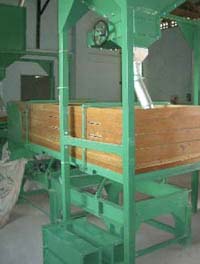
Figure 38. Green bean grading machine
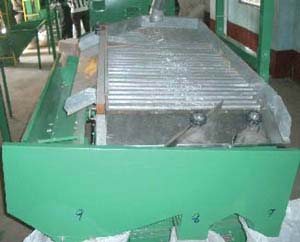
Figure 39. A densiometric sorting table
The following table present a summary of processing factors and their potential problems, which can influence Arabica quality in the washed / semi-washed processes.
Washing process for Arabica coffee
|
Process step |
Factors reducing quality |
Potential problem |
|
Harvesting cherry |
Harvest green cherry |
Green or grassy flavour |
|
Harvest over-ripe cherry |
Fermented or fruity flavour |
|
|
Pick fallen old cherry from the ground |
Fermented or fruity flavours. Mould contamination producing mouldy or musty flavours |
|
|
Hold fresh cherry for long periods before pulping |
Fermented or fruity flavours |
|
|
Pulping cherry |
Poor quality pulping equipment or poorly adjusted equipment |
Nipped beans causing stinker beans |
|
Fermentation |
Over-fermentation |
Fermented, fruity, sour or onion flavour |
|
Poor hygiene in fermentation tanks leaving a small number of extremely over fermented beans |
Stinker beans producing foul rotted or sour flavours |
|
|
Washing |
Poor washing leaving mucilage on parchment |
Mould growth producing mouldy or musty flavours |
|
Drying of parchment |
Contaminated by drying on the ground or dirty drying surfaces |
Earthy flavours. Mould contamination producing mouldy or musty flavours |
|
Stored partially dry for long periods or rewet during drying |
Mould growth producing mouldy or musty flavours |
|
|
Machine drying too fast, too hot, or uneven |
Poor, mottled or faded colour, dull or bland flavour |
|
|
Coffee is over-dried |
Poor, faded bean colour. Damages easily during hulling |
|
|
Storing dried parchment |
Stored dried parchment too wet |
Mould growth producing mouldy or musty flavours |
|
Stored near fuels or chemicals |
Contaminated with foul odours |
|
|
Hulling dry parchment |
Incorrect huller setting |
Bean damage |
|
Coffee too dry |
Bean damage |
|
|
Storing hulled green bean |
Storing too wet |
Mould growth producing and mouldy or musty flavours |
|
Stored near fuels or chemicals |
Contaminate with foul odours |
|
|
Stored in jute bags made on machinery lubricated by petroleum oils |
Contaminated with baggy or oily taints |
|
|
Stored in hot humid condition for long periods |
Mould growth producing mouldy or musty flavours. Surface oxidation of beans causing woody flavoursFaded bean colour |
|
|
Transport |
Rewetting of coffee due to leaky tarpaulins or containers |
Mould growth producing mouldy or musty flavours |
|
Stored near fuels or, chemicals |
Contaminated with foul odours during storage |
Lao is encouraged to set up its own standards for coffee quality for export using the above excerpts as guidelines in consultation with the International Coffee Organisation Standards and Guidelines on Coffee Quality.
Mould and Ochratoxin A (OTA) minimisation through good handling practices should also be consulted. National maximum limits for OTA in parts per billion are quoted from ECC Guidelines. Lao needs to carefully take note of ways to minimise OTA in coffee (see page 54 for the excerpt, OTA Risk Management: Guidelines for Green Coffee Buying 11 January 2005.
National maximum limits for Ochratoxin A
| |
Green |
Roasted |
Instant |
|
Czech Republic |
10 |
10 |
10 |
|
Finland |
5 |
5 |
5 |
|
Germany |
- |
3 |
6 |
|
Greece |
20 |
- |
- |
|
Hungary |
15 |
10 |
10 |
|
Italy |
8 |
4 |
4 |
|
Netherlands |
- |
10 |
10 |
|
Portugal |
8 |
4 |
4 |
|
Spain |
8 |
4 |
4 |
|
Switzerland |
5 |
5 |
5 |
|
The carcinogenic toxin, Ochratoxin A (OTA) can be produced in mouldy coffee. All necessary steps should be taken to avoid this problem (see page 44 for details) |
